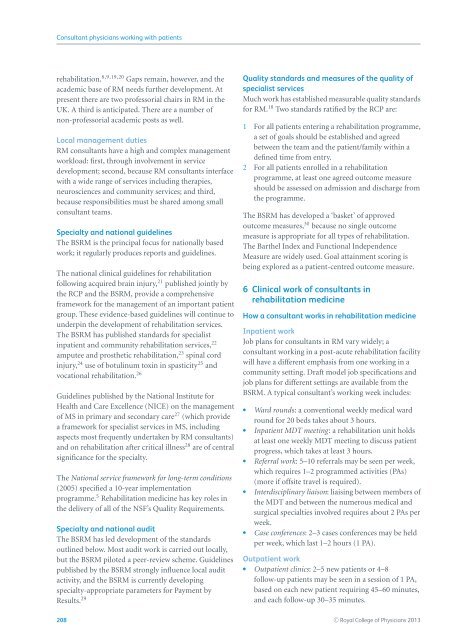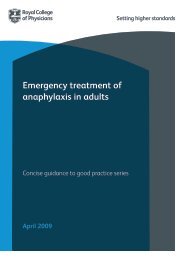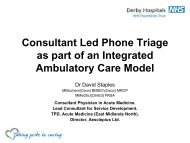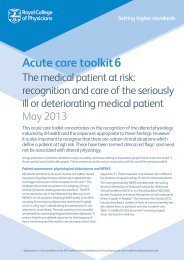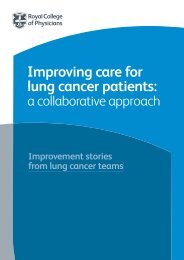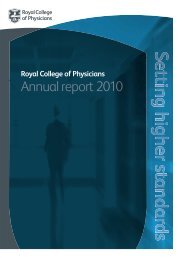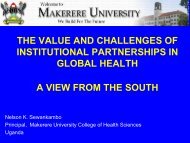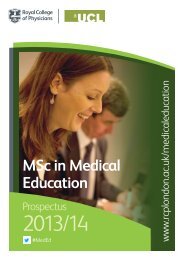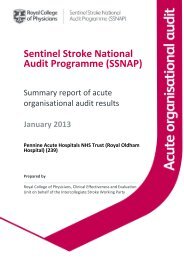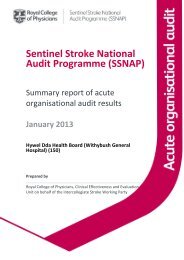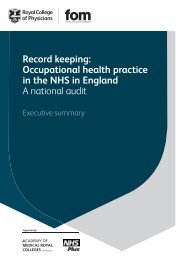Consultant physicians working with patients - Royal College of ...
Consultant physicians working with patients - Royal College of ...
Consultant physicians working with patients - Royal College of ...
You also want an ePaper? Increase the reach of your titles
YUMPU automatically turns print PDFs into web optimized ePapers that Google loves.
<strong>Consultant</strong> <strong>physicians</strong> <strong>working</strong> <strong>with</strong> <strong>patients</strong>rehabilitation. 8,9,19,20 Gaps remain, however, and theacademic base <strong>of</strong> RM needs further development. Atpresent there are two pr<strong>of</strong>essorial chairs in RM in theUK. A third is anticipated. There are a number <strong>of</strong>non-pr<strong>of</strong>essorial academic posts as well.Local management dutiesRM consultants have a high and complex managementworkload: first, through involvement in servicedevelopment; second, because RM consultants interface<strong>with</strong> a wide range <strong>of</strong> services including therapies,neurosciences and community services; and third,because responsibilities must be shared among smallconsultant teams.Specialty and national guidelinesThe BSRM is the principal focus for nationally basedwork; it regularly produces reports and guidelines.The national clinical guidelines for rehabilitationfollowing acquired brain injury, 21 published jointly bythe RCP and the BSRM, provide a comprehensiveframework for the management <strong>of</strong> an important patientgroup. These evidence-based guidelines will continue tounderpin the development <strong>of</strong> rehabilitation services.The BSRM has published standards for specialistinpatient and community rehabilitation services, 22amputee and prosthetic rehabilitation, 23 spinal cordinjury, 24 use <strong>of</strong> botulinum toxin in spasticity 25 andvocational rehabilitation. 26Guidelines published by the National Institute forHealth and Care Excellence (NICE) on the management<strong>of</strong> MS in primary and secondary care 27 (which providea framework for specialist services in MS, includingaspects most frequently undertaken by RM consultants)and on rehabilitation after critical illness 28 are <strong>of</strong> centralsignificance for the specialty.The National service framework for long-term conditions(2005) specified a 10-year implementationprogramme. 5 Rehabilitation medicine has key roles inthe delivery <strong>of</strong> all <strong>of</strong> the NSF’s Quality Requirements.Specialty and national auditThe BSRM has led development <strong>of</strong> the standardsoutlined below. Most audit work is carried out locally,but the BSRM piloted a peer-review scheme. Guidelinespublished by the BSRM strongly influence local auditactivity, and the BSRM is currently developingspecialty-appropriate parameters for Payment byResults. 29Quality standards and measures <strong>of</strong> the quality <strong>of</strong>specialist servicesMuch work has established measurable quality standardsfor RM. 18 Two standards ratified by the RCP are:1 For all <strong>patients</strong> entering a rehabilitation programme,a set <strong>of</strong> goals should be established and agreedbetween the team and the patient/family <strong>with</strong>in adefined time from entry.2 For all <strong>patients</strong> enrolled in a rehabilitationprogramme, at least one agreed outcome measureshould be assessed on admission and discharge fromthe programme.The BSRM has developed a ‘basket’ <strong>of</strong> approvedoutcome measures, 30 because no single outcomemeasure is appropriate for all types <strong>of</strong> rehabilitation.The Barthel Index and Functional IndependenceMeasure are widely used. Goal attainment scoring isbeing explored as a patient-centred outcome measure.6 Clinical work <strong>of</strong> consultants inrehabilitation medicineHow a consultant works in rehabilitation medicineInpatient workJob plans for consultants in RM vary widely; aconsultant <strong>working</strong> in a post-acute rehabilitation facilitywill have a different emphasis from one <strong>working</strong> in acommunity setting. Draft model job specifications andjob plans for different settings are available from theBSRM. A typical consultant’s <strong>working</strong> week includes: Ward rounds: a conventional weekly medical wardround for 20 beds takes about 3 hours. Inpatient MDT meeting: a rehabilitation unit holdsat least one weekly MDT meeting to discuss patientprogress, which takes at least 3 hours. Referral work: 5–10 referrals may be seen per week,which requires 1–2 programmed activities (PAs)(more if <strong>of</strong>fsite travel is required). Interdisciplinary liaison: liaising between members <strong>of</strong>the MDT and between the numerous medical andsurgical specialties involved requires about 2 PAs perweek. Case conferences: 2–3 cases conferences may be heldper week, which last 1–2 hours (1 PA).Outpatient work Outpatient clinics: 2–5 new <strong>patients</strong> or 4–8follow-up <strong>patients</strong> may be seen in a session <strong>of</strong> 1 PA,based on each new patient requiring 45–60 minutes,and each follow-up 30–35 minutes.208 C○ <strong>Royal</strong> <strong>College</strong> <strong>of</strong> Physicians 2013


